Texas Style Smoked Beef Brisket
On April 15, 2025
This post may contain affiliate links. Please read our disclosure policy.
Texas Style Smoked Beef Brisket is more than a simple recipe, it’s a process for melt in your mouth smoked brisket. All you need is salt, pepper, smoke, and time, and you’re on your way to eating the best beef brisket of your life.
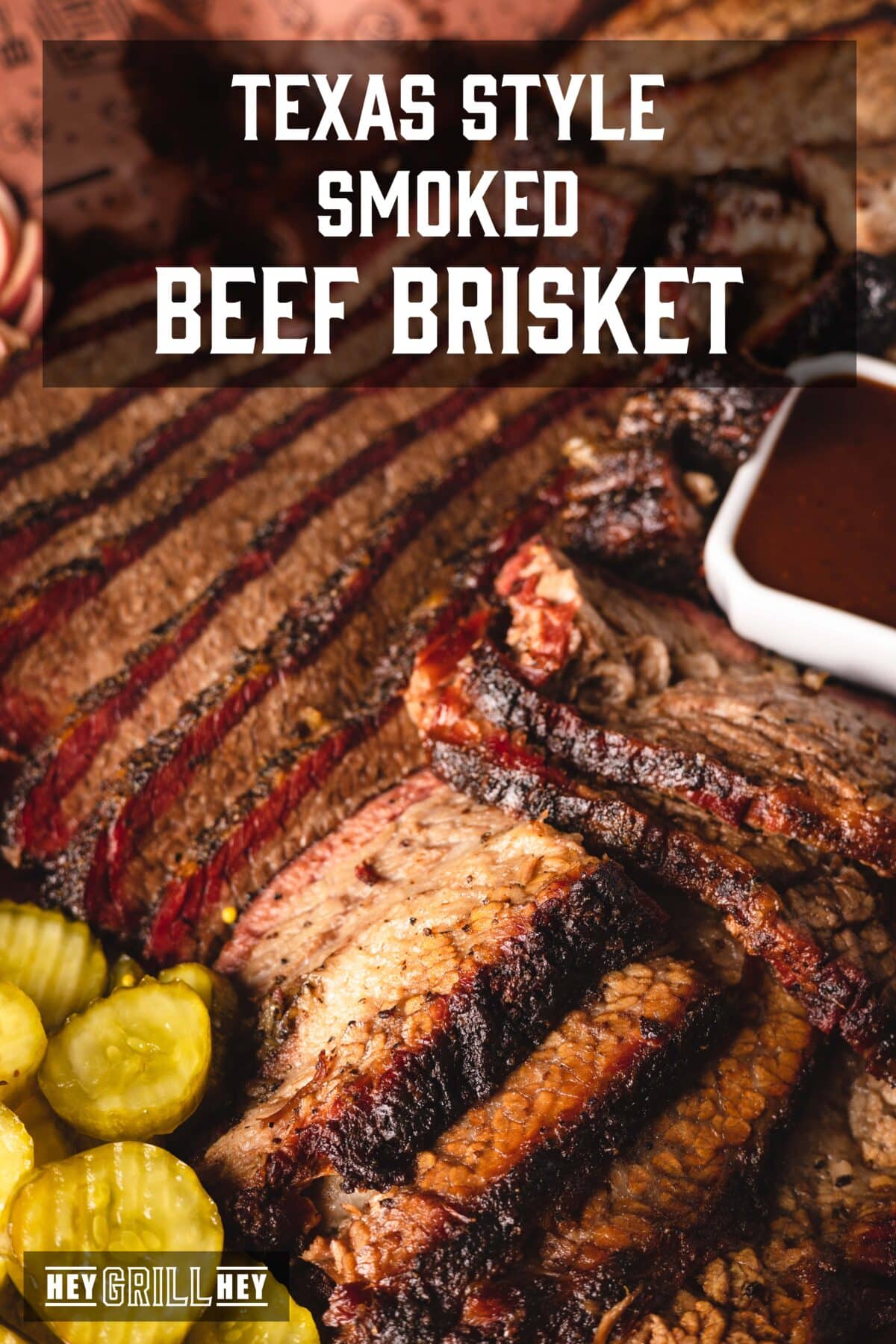
Smoked Brisket
I totally understand how intimidating it can be to smoke a huge, expensive brisket for the first time. That’s why I’ve tested and re-tested many different methods and recipes to help you achieve perfect results every time using a relatively simple process.
Once you try this juicy brisket, you’ll be itching for the next opportunity to smoke another one. BBQ (especially brisket) is something you have to learn by experiencing it yourself, so let’s jump in and give it our best go!
Tools Needed to Smoke Brisket
I have linked the products that I use when smoking my brisket below so you can see exactly what I’m using at home. Not all of these are necessary, but after smoking a bunch of briskets, I have found they make the job a lot easier!
- Smoker. I like to use my CampChef Woodwind Pro, but any variety that can hold a steady temperature of 225 degrees F will work great.
- Large Cutting Board. You’ll need a big surface to slice your hunk of brisket on once it’s ready to serve. I love this large, grooved cutting board so I have room to work when it’s time to slice.
- Meat Thermometer. The Thermapen ONE from Thermoworks is the perfect thermometer for this brisket, but any reliable thermometer will do.
- Butcher Paper. This Texas style brisket is wrapped in butcher paper during the stall.
- Chef’s Knife. A good, sharp knife is necessary to slice your brisket. This Dahstrong Chef Knife is perfect for the job.
Selecting Your Brisket
I have a full write up about choosing the perfect brisket in my Brisket 101 post, but here are the basics:
- What cut? Plan on purchasing a whole packer brisket with both the point and flat muscle included.
- What to look for. The grade of your meat matters, prime beef will have more fat marbling. (This means more flavor and juiciness than a choice graded brisket!).
- How much brisket to buy. Buy about ½ pound (or more) of brisket per person you are serving.
How to Trim a Brisket
Some Texans claim they don’t trim at all. At most of the top smokehouses, however, they do trim. This step is so important for how the final product will turn out. Spend the 20-30 minutes you need to trim it properly. I have step by step instructions (and pictures) for trimming your brisket in this post: How To Trim a Brisket. There is also a sped-up version in the video (below the recipe card) that will help you get a visual for a trimmed brisket.
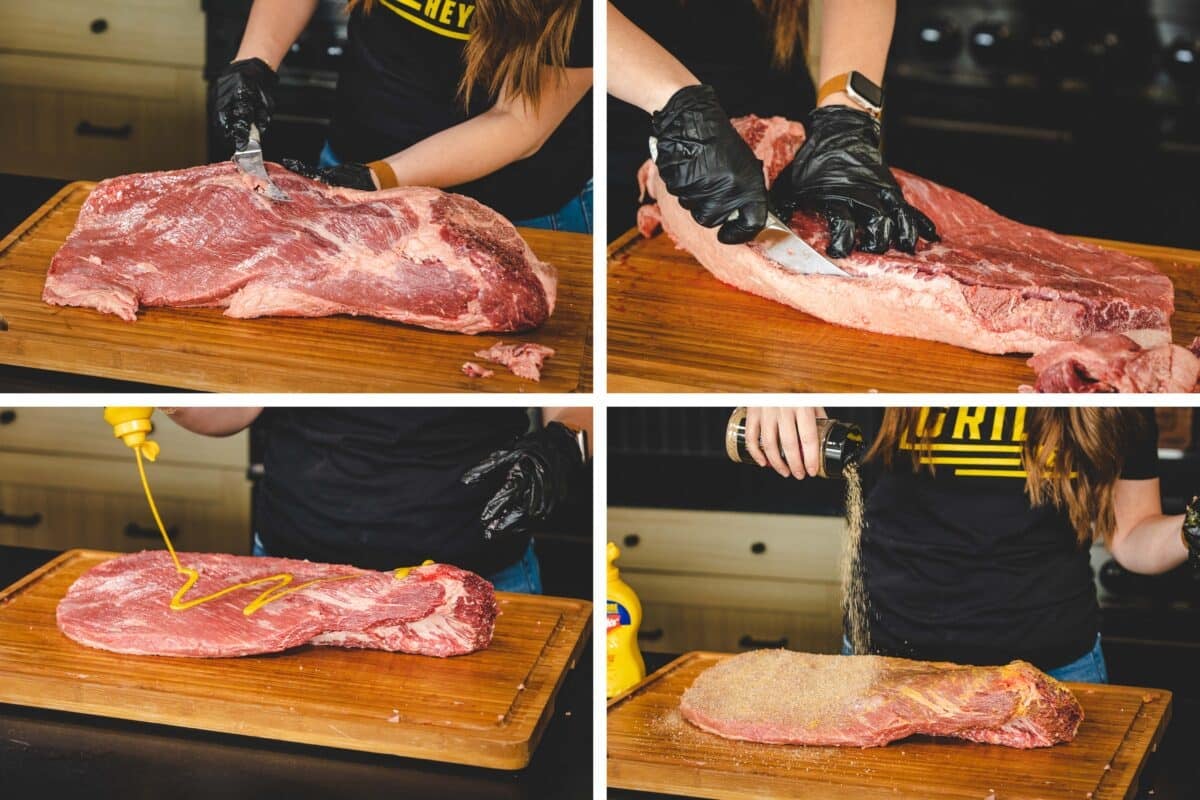
Seasoning your Brisket
Texas style is seasoned with only coarse salt and coarse black pepper. My only addition (and this is personal preference, you can skip it if you’re a purist) is to add garlic powder as well. It doesn’t really change the flavor or take away from that amazing smoked beef, but adds a little extra layer of goodness.
How Long to Smoke a Brisket
I wish I could tell you an exact time that smoking will take, but alas, that’s kind of the beauty of BBQ. It’s done when it is done.
For the initial smoke phase, I plan about 8 hours at 225 degrees F for my 12-13 pound briskets to reach 165 degrees F. However, your brisket will enter a phase in between 145 degrees F and 165 degrees F where the liquid evaporating from the surface of the brisket will cool it while your grill is trying to cook it. This is called “the stall,” and the time frame is different during this phase for every brisket I’ve ever cooked. This is where a good internal thermometer comes in.
The second phase (once it’s wrapped in butcher paper), can take anywhere from 5-8 hours. I usually plan an extra 2 hours for each of my brisket cooks because if it is done early, I can always set it in a cooler and allow it to rest for a while. If it is done late my husband gets hangry.
Bottom line, plan for anywhere from 12-18 hours to fully cook your brisket (this includes the initial smoke to 165 degrees and the wrapped smoke to get your meat up to 202 degrees Fahrenheit).
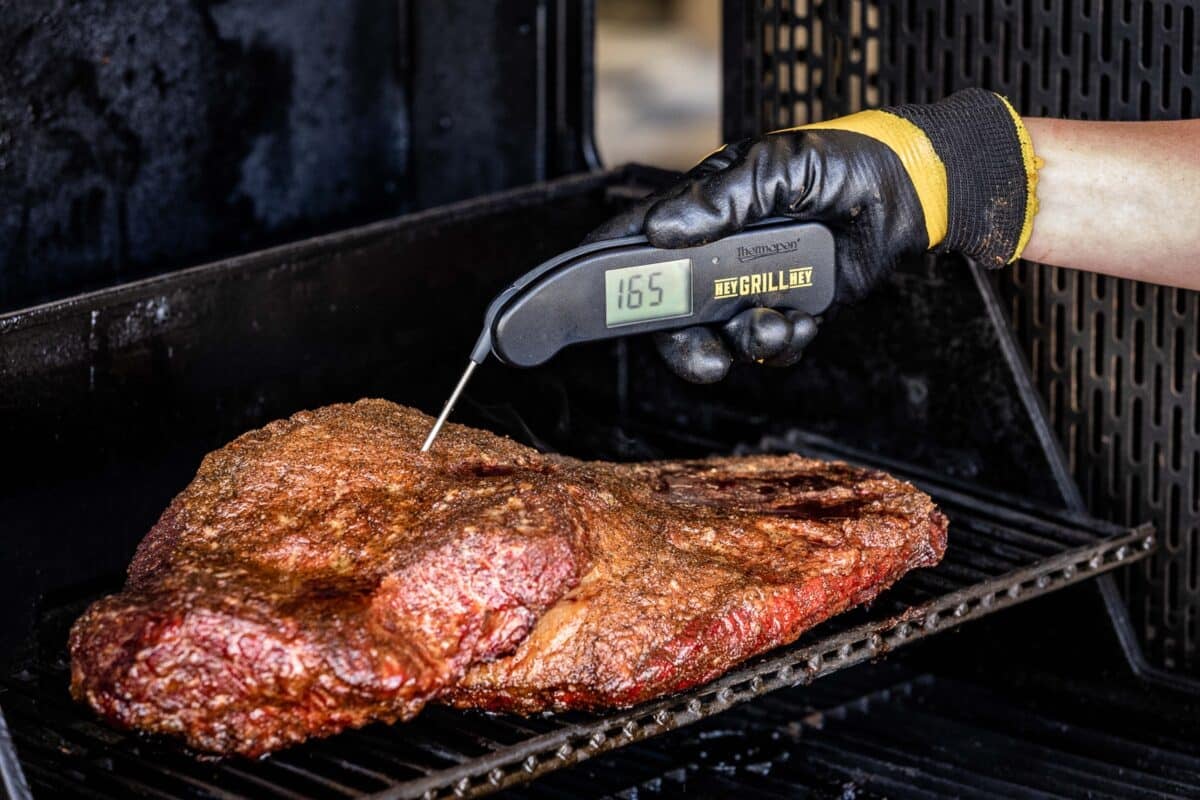
The First Smoke
Smoking brisket isn’t hard, it just takes time, and lots of it! Follow the steps below to get the best smoked brisket of your life:
- Preheat the smoker. Set your smoker to 225 degrees F, and be sure to load it with a nice hardwood. I used oak as the base wood with a little bit of cherry mixed in. The goal here, whatever type of smoker you are using, is consistent heat and a steady flow of thin blue smoke.
- Smoke the brisket. Placed your trimmed and seasoned brisket directly on the grates of your smoker. There’s some debate on whether smoking with the fat cap up or down is best. If you’re dealing with direct heat, smoking fat side down can help protect the meat. When it comes to indirect heat, I smoke with that layer of fat up. You want your brisket to reach an internal temperature of 165 degrees F in the thickest part before moving forward.
For a 12-14 pound brisket, estimate around 8 hours for this initial smoke. As always, each brisket and smoker is a little different. Cooking times are always an estimate, and cooking to the proper internal temperature is the best way to ensure a fully-cooked, melt-in-your-mouth brisket.
How to Wrap a Brisket
This is one of the most crucial steps, in my opinion, to achieving that super juicy tender brisket with that killer dark caramelized bark. Opinions differ between using foil and peach butcher paper, but for this recipe I am fully converted to the butcher paper after years of using foil. My briskets have never had a better smoke flavor and a more delicious bark.
The brisket gets wrapped up like a present, folding edge over edge until it is fully sealed. Return the brisket to your smoker with the folded edges down and continue smoking at 225 degrees F until the internal temperature of your brisket reaches 202 degrees F at the thickest part (make sure your thermometer is in the meat, not fat).
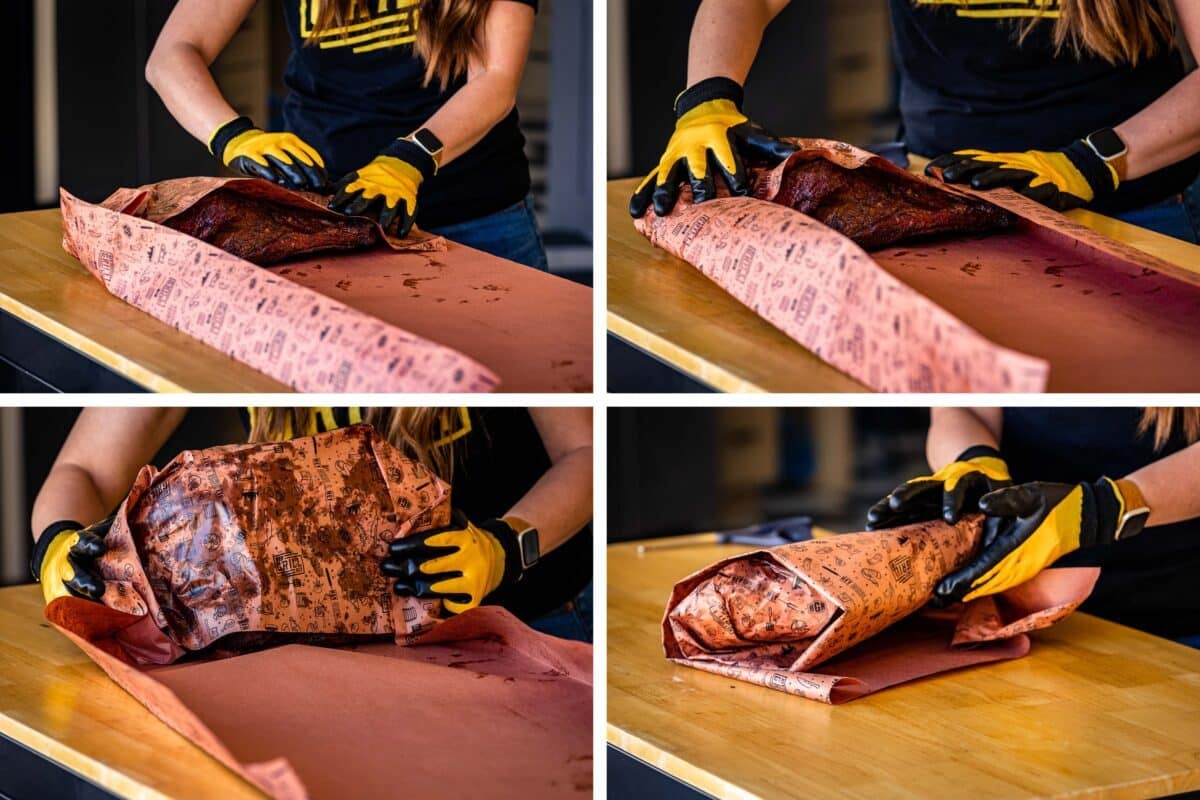
How Long to Rest Brisket
DO. NOT. SKIP. THIS. STEP. Resting your brisket allows so many of those hot and bubbly juices to settle down a little and redistribute to the meat. It also brings your brisket down to perfect slicing and serving temperature.
If you’re going to be serving your brisket within the hour, you can let your brisket rest at room temperature. If your brisket is done early, I recommend holding the brisket in an insulated cooler until you’re ready to slice and serve. Your brisket will continue cooking as it rests at this temperature and will be exceptionally tender if you rest in a cooler.
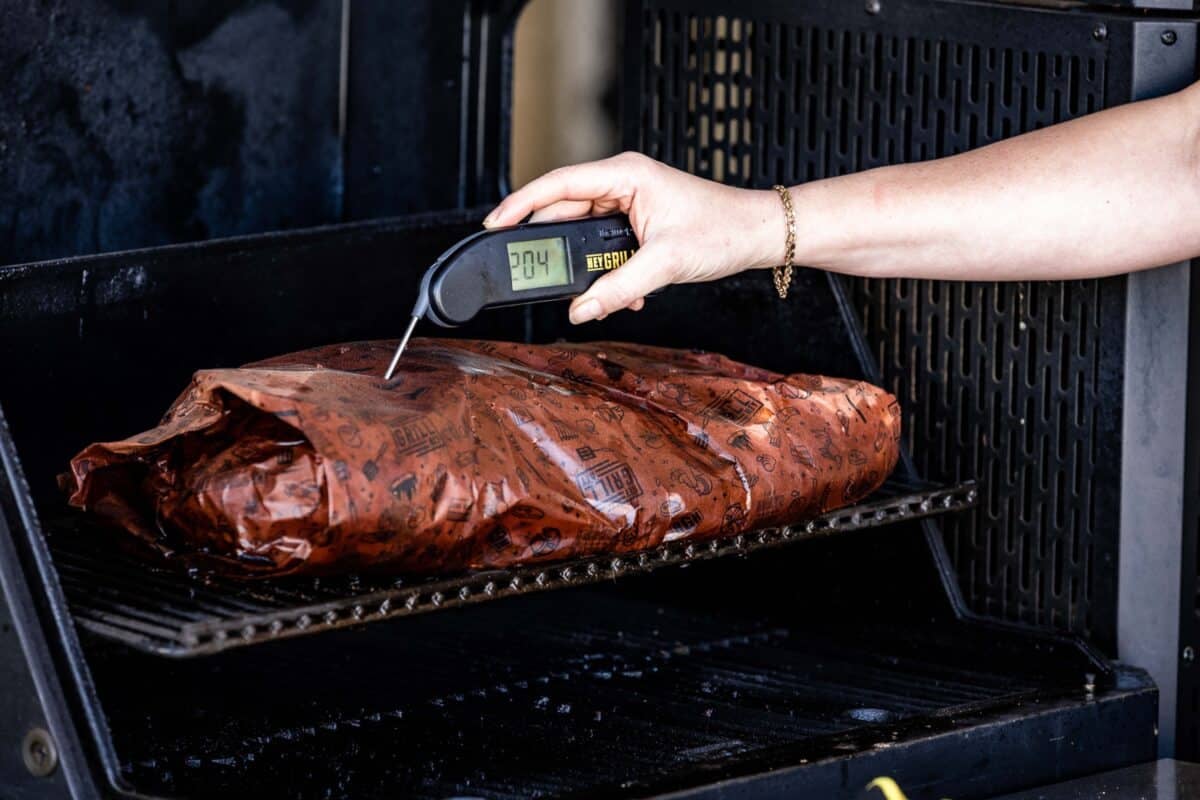
How to Slice a Brisket
You want to slice your smoked brisket against the grain for maximum tenderness. But remember, there are two overlapping muscles and two different grain directions. You can split the point and flat sections and slice each individually against the grain before serving but that sometimes leaves pieces with no bark on top.
Traditional Texas joints split the brisket down the middle, as close as possible where to point overlaps the flat, they then turn the point 90 degrees and slice it that way and then finish slicing the flat the opposite way. You will have some pieces where they grain isn’t perfect but if your meat is tender enough it won’t matter too much.
I have a full post with pictures on how to slice a brisket HERE.
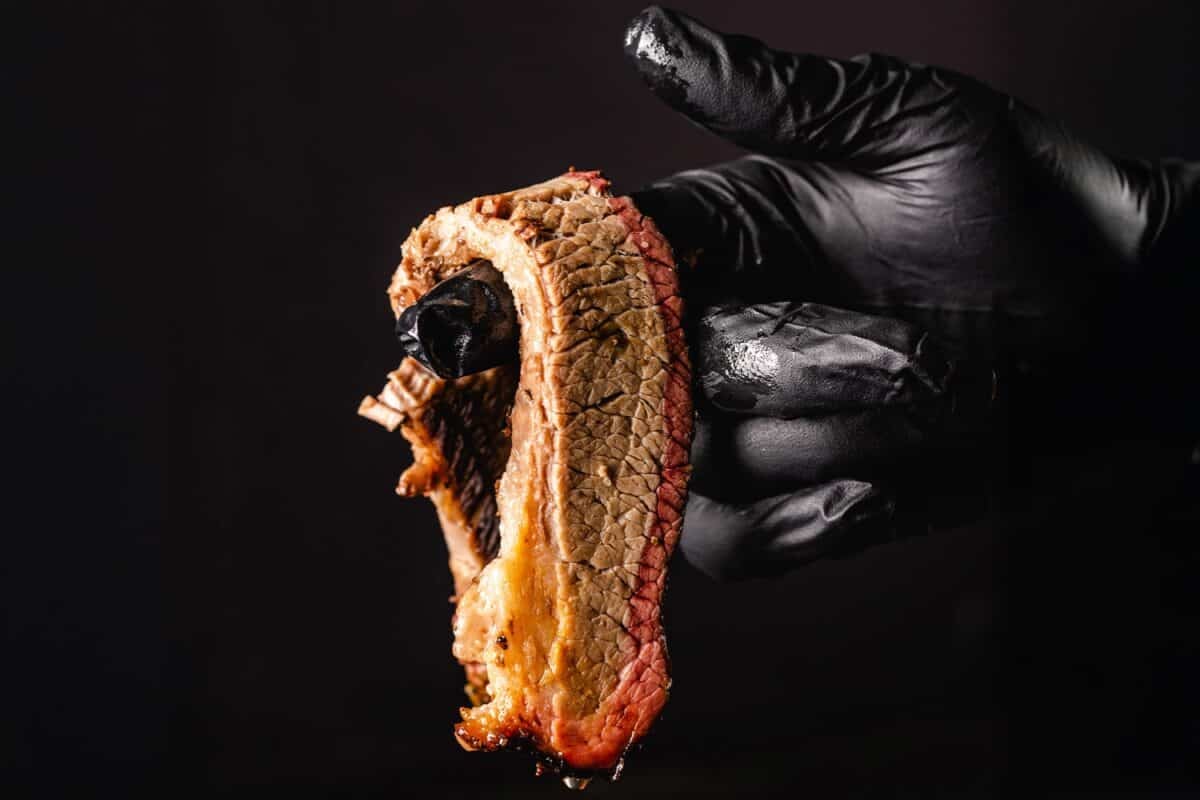
What to Serve with Smoked Brisket
In Texas joints when you order, you can request fatty or lean brisket. The fatty is the point and the lean is the flat. I like to tell my guests which slices are which so they can pick their favorite. The fatty is my personal preference, but I always grab a slice of the lean too because it has such an amazing smoke flavor!
For an even more traditional experience, serve on a platter with butcher paper, lots of pickles, white bread, picked red onions, and pickled jalapenos. Sauce on the side. Always.
Tips for the Best Smoked Beef Brisket
Check out these pro tips to give you the upper hand when smoking your brisket:
- Don’t forget to rest! Resting your brisket is extremely important. I recommend resting your brisket for at least one hour. You can just leave it in the butcher paper and set it on a cutting board or baking sheet. If you need to rest your brisket for more than an hour, that is no problem! Simply wrap it in a towel (one you don’t mind sacrificing for tasty brisket) and set it in an insulated cooler. I’ve held briskets this way for up to 6 hours and they come out hot and perfect every time!
- Mix your spices in advance. Mix your salt, pepper, and garlic in an old spice shaker container. Shake the spices out at about 2 feet above your brisket while seasoning. This will create a nice even layer of salt, pepper, and garlic across the entire surface of your brisket.
- Either side up cooks just fine! Many people argue whether you should cook your brisket with the fat side up or down when smoking. Guess what? I did two briskets, one up and one down. There was no difference in final product. Place it on there however you prefer!
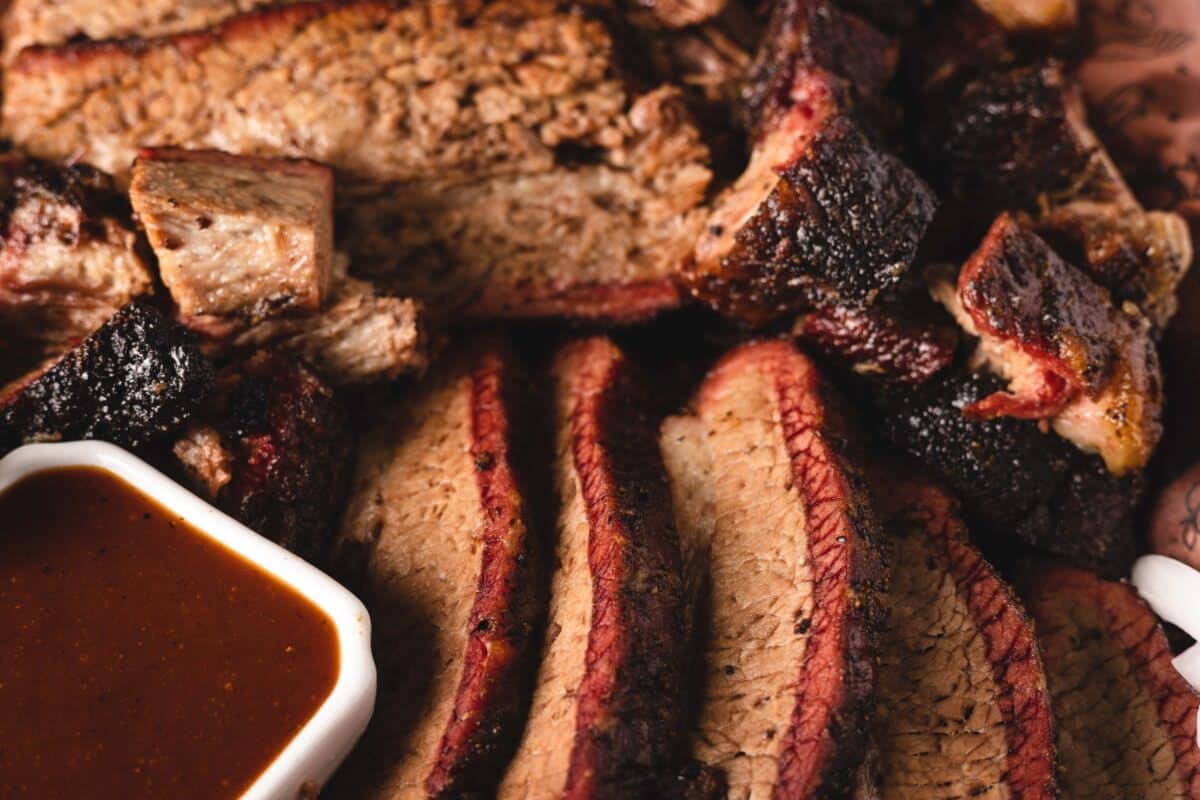
Variations for Smoked Brisket
Not all brisket methods are the same, and I often try different techniques to get the best results. Here are a couple of variations you can try:
- Slather! Some people like to use a binder to help the rub adhere to the brisket. My favorite is yellow mustard (or my Zesty Gold BBQ Sauce). This helps the seasoning stick, but the acidity also helps break down the surface of the meat and create a gorgeous bark. It’s not necessary, but worth a try to see if you like it!
- Wrap! I recommend wrapping in butcher paper, but foil is also an option. In fact, aluminum foil is the original Texas crutch to help push smoked meat through the stall. It’s still used in many BBQ joints. Your brisket may have a softer bark, but it will maintain a lot of moisture inside the meat itself.
- Temperature! I like low and slow for my briskets, but some people like the process to hurry a long a bit. You can try smoking at 275 degrees F to shorten the cook time. There’s no perfect formula to have a perfect time line, so keep an eye on the internal temp of your brisket.
Smoked Brisket Recipe
Watch the video below the recipe card and I’ll show you step-by-step how I make this smoked brisket at home.
When you’re ready to master the art of smoked brisket, check out The Grill Squad. I’ve got an in-depth course with workbooks and videos walking you through every step of the process.
I’m on a mission to help you become a Backyard BBQ Hero, so head on over to YouTube, Instagram, or Facebook to get more recipes, videos, and tips from Hey Grill Hey. We can’t wait to hear from you!
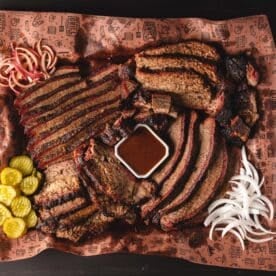
Texas Style Smoked Beef Brisket
Video
Equipment
- 1 Smoker I highly recommend this pellet grill!
- butcher paper
Ingredients
- 1 12-14 pound whole packer brisket
- 2 Tablespoons coarse Kosher salt
- 2 Tablespoons coarse black pepper
- 2 Tablespoons garlic powder (optional)
Instructions
- Prepare and trim the brisket. Store your brisket in the refrigerator until you are ready to start trimming. Cold briskets are much easier to work with. Flip your brisket over so the point end is underneath. Remove any silver skin or excess fat from the flat muscle. Trim down the large crescent moon shaped fat section until it is a smooth transition between the point and the flat. Trim and excessive or loose meat and fat from the point. Square the edges and ends of the flat. Flip the brisket over and trim the top fat cap to about 1/4 of an inch thickness across the surface of the brisket.1 12-14 pound whole packer brisket
- Season the brisket. In a mixing bowl or empty spice container, mix the salt, pepper, and garlic. Share over the brisket to evenly distribute the spices on all sides.2 Tablespoons coarse Kosher salt, 2 Tablespoons coarse black pepper, 2 Tablespoons garlic powder
- Smoke the brisket. Set your smoker to 225 degrees F using indirect heat and hardwood smoke. Place the brisket on the smoker with the point end facing your main heat source. This is a thicker part of the brisket and it can handle the additional heat. Close the lid and smoke until and internal thermometer reads 165 degrees F (usually takes around 8 hours).
- Wrap the brisket. On a large work surface, roll out a big piece of butcher paper (or foil) and center your brisket in the middle. Wrap the brisket by folding edge over edge, creating a leak proof seal all the way around. Return the wrapped brisket to the smoker, seam side down so the weight from the brisket crimps the edges of the paper wrap down tight.
- Smoke the brisket again. Close the lid on the smoker and, maintaining 225 degrees F, continue cooking until the internal temperature of the brisket reaches 202 degrees F in the thickest part of the meat (takes anywhere from 5-8 hours).
- Rest the brisket, then slice and serve. Remove the brisket to a large cutting board and allow to rest for 1 hour before slicing. Slice both the point and the flat against the grain with a sharp knife and serve immediately.
Nutrition
Nutrition information is automatically calculated, so should only be used as an approximation.
**I originally published this post in June 2017, but have since updated it with updated photos, more information, and helpful tips. However, the recipe remains the same.
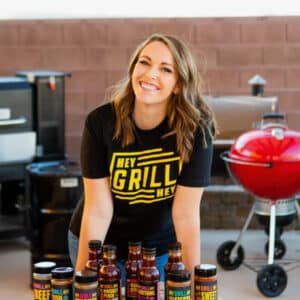

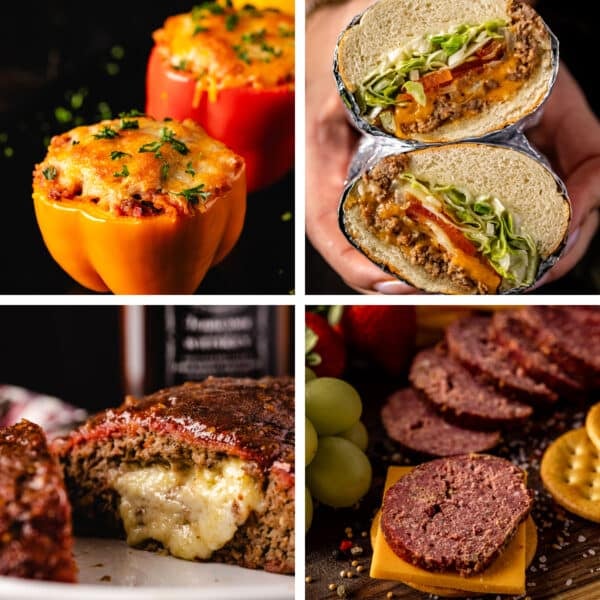
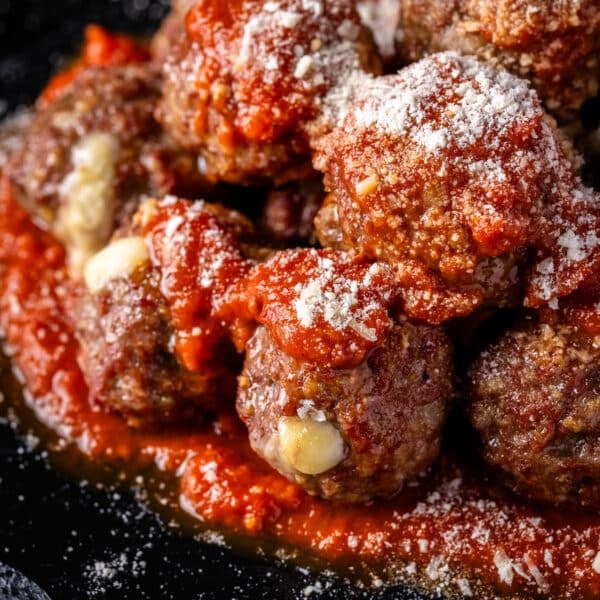
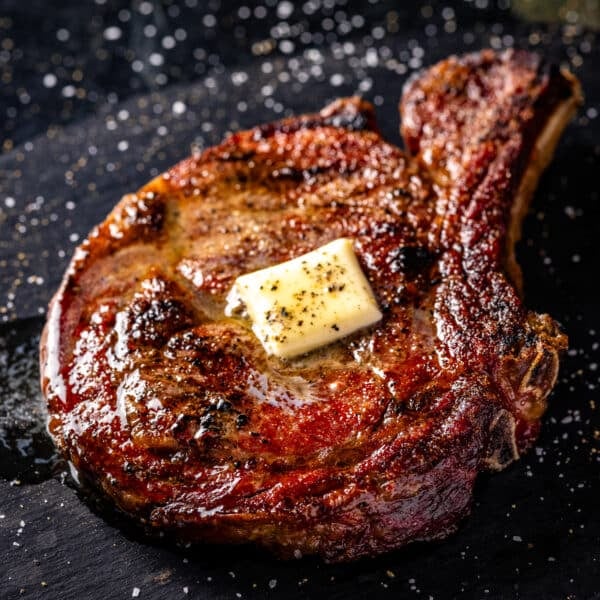





Can parchment paper be used instead of the butcher paper?
Absolutely! Just make sure it is unwaxed.
Hi,
If I have to serve it like the next day, do I put it in the freezer? how do I heat it? Thank you
I would refrigerate, not freeze, and reheat at a low temperature while it’s still wrapped up until it just hits 145, serving temp.
What do you change for cooking times if all I can get is the flat? I have an 8lb choice flat and a green mountain grill wood pellet smoker. Suggestions?
Thanks!
Hey Chad- I usually try to plan about an hour per pound at 225 degrees F. If it’s done early, you can wrap it in towels and let it rest in a cooler. It will stay hot for several hours that way.
Perfect, thanks! We got all the stuff to follow the rest of the recipe to a tee. This is my first brisket. Wish me luck!
I have butcher paper but I’m pretty sure it’s white. What’s the reasoning behind “peach” butcher paper and could I just use what I have? Thanks!
Hey Annie- white butcher paper is totally fine! Just make sure it isn’t waxed on one side. The only difference is that white paper is typically bleached, and more expensive. The peach paper tends to cost a little less.
By “waxed on one side”, do you mean shiny? I can’t find any butcher paper that isn’t shiny on one side, but it doesn’t appear to be wax.
Yes, the shiny stuff is almost always a wax coating. There is some that is smoother on one side that’s not waxed. Just read the box or item description if you’re shopping online- it will tell you if it’s waxed or not.
Dumb question – waxy in or out ?
Shiny side out! If you can though I’d try and find some paper without wax. Here’s a link to what I use: https://heygrillhey.com/store/products/hey-grill-hey-branded-butcher-paper/
The only problem I have is I have a Treagar smoker and on smoke sitting it may get up to 187 there is no way you can set it on 225, so I will have to add a few hours to mine.
Holly- I would use the “smoke” setting for the first three hours and then turn the heat up to medium to finish cooking. It may actually shorten the total cook time, so you won’t be spending 2 days cooking your brisket. Most of the smoke penetration happens in the first 3 hours anyways, so it would still be amazing!
I’m trying this tonight, I also have a traeger smoker but my brisket is a touch lighter (and leaner looking with zero fat cap on one side) so have left it on the smoke setting at 185-190 – It’s been there for a total of 12 hours thus far, wrapped it after 10 hours with the butcher paper.
Hoping it’s a hit tonight!
I just cooked my first brisket on my new Traeger, it is dry….I mopped it and used meat thermometer. Good flavor, but dry! Any pointers???
Hmm, what temperature did you smoke it at? And did you wrap it?
sometimes it is the meat, not having enough fat will make it dry. There was a guy in the meat dept that would pick up a brisket and hold it in the middle if it hung down on the edges he put it back if it held it’s level it had enough fat that is cold to make a moist BBQ. he was right too!
Separate the point & flat a couple hours before you plan to serve.
Put the flat back in FCT, and slice that point into 1″x1″ cubes into an aluminum pan.
Drizzle some of the juices from your brisket drip pan over the cubes & lightly baste with some sweet/spicy bbq sauce – not too much now.
Put these back on the heat uncovered for half an hour-45min just to firm em up a bit/caramelize the sauce.
Poke each one with a Texas flag tooth pick & serve an awesome burnt ends appetizer while you slice the flat.
I love burnt ends! Now all I need is some Texas flag toothpicks!!
this sounds delicious, but I don’t have a smoker grill only a charcoal grill. Can I still us it to cook a brisket?
Hey Paula! It can be hard to maintain these low temperatures for that long on a charcoal grill. I would recommend setting your grill up for indirect cooking (charcoal on one side, meat on the other) and using large wood chunks for smoke. I would try and keep my grill temp around 275 degrees, which will mean shorter cook times. Keep an eye on the internal temperature of your brisket during the process and you should be good to go!
I cheat! I marinate my meat and then wrap in foil and put in oven for about 3 hours at 275. I then let it rest until it firms up and then put on smoker with chunks of hickory or pecan and bring temp to 225-240 and cook in foil for about 4 hours rotating ends occasionally. I then remove foil and baste it with sauce, honey, brown sugar and a little liquid smoke for about an hour , rest and then slice! Perfect everytime!
That makes no sense? You put on the smoker wrapped in foil, how does that get any smoke?
I am wondering the same thing!
Smoke only goes into the meat so far. They rest of the time heat cooks the meat, it doesn’t need smoke as it only goes in so far. Wrapping it speeds the finish time and holds in the juices.
How long should I cook if I’m only doing half a brisket.. so about 7 lbs?
I’d plan for about an hour per pound. I suggest you make sure to give yourself some extra time. If it gets done early you can always wrap it in a towel and put it in a cooler until you’re ready to eat.
Last week I tried a new method for me. I lined the charchol up like a snake around the outside edge of my Weber grill. I left about 6 inches between the start of the circle and the end. I then placed the soaked wood chips on top of the charcoal. Then I started one end of the snake. As the charcoal worked its way around it provided me with a good strong 250-300 degree heat for over 8 hours. The 4 Turkey breasts came out far better than expected. Very smoky and plenty of heat/time to get a “GOOD JOB HONEY” kiss from my sweetheart. I found this technick on a facebook posting
Sounds like it was a success! Thanks for sharing your technique!!
I cooked a brisket using the snake/coil
method and it was amazingly good. You have to make sure you put a pan of water in the center to keep adding moisture back in with the heat. If you have enough Kingsford charcoal (only brand to buy) it will last several hours at 200 degrees. I bought a wireless temperature gauge for $20 so I can monitor the inside temp in the thickest part of the meat.
That’s great! The snake method is awesome. I used it just the other day again on a couple racks of baby backs.
Don’t forget to put a water pan underneath the meat, next to the coals. Fill up at least half way. The water adds moisture to the inside and keeps the temp down. I have been doing briskets and ribs on my grill for years. You do have to pay close attention to the coals and will have to add wood every couple of hours. If you have a thermometer with two sensors you are in good shape. 1 monitors the temp inside the meat. The other the temp inside your grill.
HI Paula,
I know this comment is a little late, but i the winter due to having trouble keeping the temps stable in my smoker, I do a heavy smoke for 2-3 hours then wrap in foil and finish off in the oven at 180-22 (depending on what I am cooking), You can use this technique with a regular grill set for indirect cooking as well.
What kind of smoker are you using? Thanks
Hi Marian! For this brisket I used a CampChef Woodwind pellet grill.
I am happy to see that pellet grills are used by an experienced competitor. I’ve read that the pellets can’t deliver the same intensity and flavor smoke ring as conventional smokers with wood chips/logs. Thus, I am reluctant to buy one (as a novice). Is there a particular pellet brand you use to deliver the flavor?
Hey Josh- I do absolutely love my pellet grill, but most people will struggle to get the full depth of smoke flavor you get from cooking on an offset. I personally prefer the slightly lighter smoke from a pellet smoker, but I still have beautiful smoke rings, great bark, and get rave reviews with my flavors so I don’t stress about it too much. If you find you’re wanting more smoke, some people supplement with an additional pellet tube (Available on amazon) inside the grill. I use Camp Chef competition blend pellets most frequently.
My first smoker I bought was an offset. It was a slightly cheaper one from Home Depot. Spent a little extra on food-safe high temp grill gasket to seal the edges and after a few practice smokes, I’ve got people telling me I make the best ribs and brisket they’ve ever had. My buddy who is a long time user of an offset bought an electric pellet smoker. It’s good, but there’s just something about the flavor from an open flame.
I have the Brinkmann fire hydrant-R2D2 looking smoker. I did a small (5 pound perhaps) test brisket for 4 July and it disappeared. And my rub of choice has always been Kosher salt and freshly ground pepper. I use a mixture of Kingsford charcoal (I prefer applewood and or hickory) and hickory wood chunks. I draped some beef plate ribs around the little brisket and smoked them for 6 hours while the brisket went overnight. I wrapped it in parchment paper and put in fridge til almost suppertime. I put it back on smoker for about an hour before we ate, just enough to heat through and kiss with smoke. The refrigeration made all the difference in the world, with the briaket and both beef and pork ribs…the collagen converted to gelatin and as we used to say in the mountains made it larrapin’ good.
First off thank you for all the details of doing a brisket right.
I’m used to my Texas brisket being served with a warm (heated) bbq sauce, something that’s deep and rich in color and taste, with a little hint of spicy.
Obviously excellent brisket which it looks like you have mastered here doesn’t need sauce. Personally for me its Texas style. When I was growing up in Hattiesburg, MS in 1974 there was a place called Lowry’s BBQ on Hardy St next to Camper Park. They had a large warmer sauce tray in the middle that had a dark rich finishing sauce you could put on as much as you wanted.
https://newspaperarchive.com/hattiesburg-american-dec-19-1977-p-29/
right side of paper there’s their old add. Well they had the BEST brisket bbq sauce I’ve ever had. I’ve searched high and low for their recipe. I’ve tried many a different recipes in the ktichen, coming close but not exactly to Lowry’s recipe.
Hey Brad! There are definitely lots of good sauces out there- I’ve found one of the best things that most Texas joints do is reserve some of the brisket drippings and mix them into the sauce.
I like to take a big bottle of ketchup and chopped up yellow onion and saute until onion is translucent…then out in some brown sugar, apple cider vinegar, chopp3d poblanos pepper, and diced pieces of the following dried fruit (peaches, plums, cherries, and apricots) as well as one full cinnamon stick (crushed) and heat on low for an hour.
The flavor with the added fruit and cinnamon is amazing
I’ve been wanting to try doing a brisket, but haven’t been brave enough! Your detailed step by step directions were so helpful! Definitely want to try doing one soon! Thanks for sharing!
Thanks Jenny Lynn! I hope it turns out just perfect for you!
I need your help, Suzie! I’m going to smoke an 18 pound brisket. How much time do you think I should allow for it to be removed from my electric smoker?
I usually estimate 1-1.5 hrs per lb. but be sure to allow yourself some extra time just in case! If it gets done early you can always wrap it in a towel and place it in a cooler to keep it hot until you’re ready to eat!
Best-Brisket-Recipe-EVER!!!! I smoked an 18 pound brisket using your recipe Susie and it was the best brisket ever! It had a wonderful smoked taste and it was super moist and juicy. I had attempted a brisket before on my smoker using another recipe from the company where I bought my smoker and it did not come out well and was really dry (and that was with injecting the meat prior to smoking). Your recipe is straight forward and easy to do, and it produces an amazing brisket. Everyone who ate it couldn’t get enough of it. Thank you Susie for sharing this with us! Your recipes are really awesome!
When I first got my smoker (Masterbuilt cabela’s brand) I tried out the brisket recipe in the manual. The next day I tried out smoked burgers (your recipe) and the day after that I smoked back ribs (again, your recipe). That was one of the best weekends of my life.
Spoiler alert: I probably should have tried this brisket recipe instead of the one in the manual. This one was way better, and it took less work to get it done. The only thing was time, which was mostly caused by a crappy thermometer. The brisket was great. I only wish I could duplicate that cook time and temp….but i guess I can always set my smoker the way I set it this weekend and stop it when I stopped it today. Brisket was awesome.
When do you wrap the brisket in the burcher paper?
I wrap mine when I’m satisfied with how the bark looks and feels. You should be able to run your finger across the bark and have none of it come off.